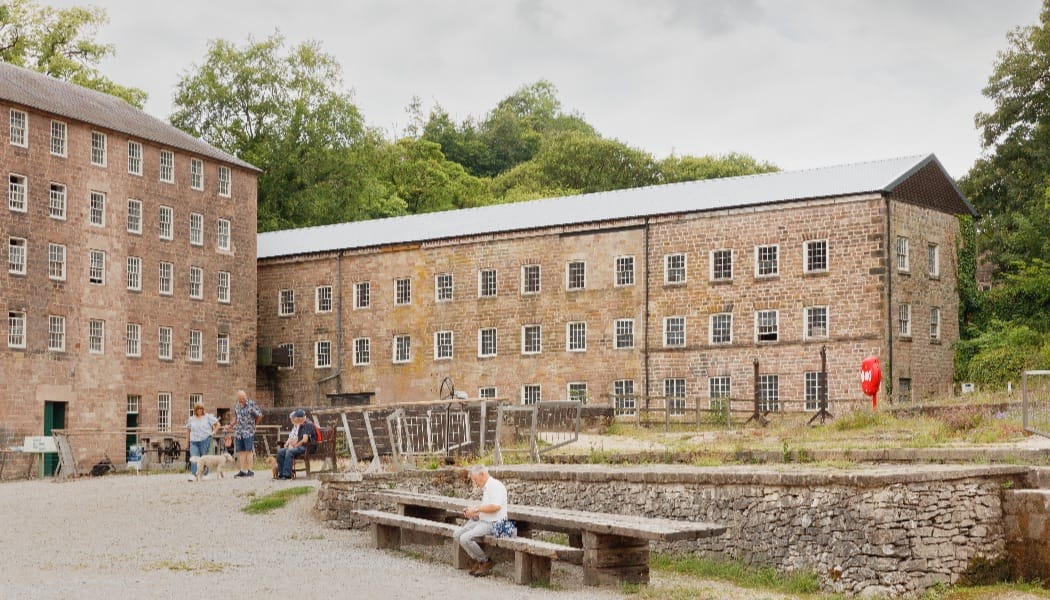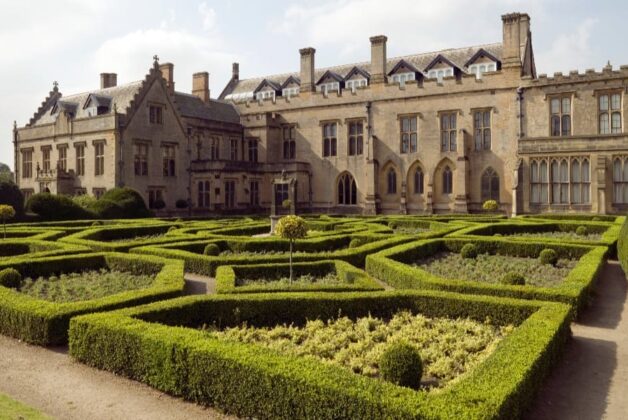Alistair Hardaker
Image: Claudia Kenyatta CBE and Emma Squire CBE, Co-CEOs of Historic England © Historic England Archive
Co-CEOs answer questions on £29bn wellbeing benefits and three-day-week job-share leadership model
Last week Historic England released its annual Heritage at Risk Register 2025, revealing an increase in heritage buildings and structures across the country.
The Register gives an annual snapshot of England’s historic buildings and places which are currently at risk of neglect, decay or inappropriate change, alongside those no longer deemed as such. This year’s report shows a net growth in heritage at risk, with 1,460 buildings and structures listed – up from 1,442 in 2024.
A total of 138 sites have been added to the register in 2025, while 129 sites have been removed, having been successfully saved and their futures secured.
The full 2025 Heritage at Risk Register includes 1,460 buildings or structures (Grade I and II* listed buildings and structural scheduled monuments across England, plus Grade II listed buildings in London), 986 places of worship, 1,864 archaeology entries (non-structural scheduled monuments), 105 parks and gardens, 3 battlefields, 4 protected wreck sites and 469 conservation areas.
Advisor spoke to Historic England’s Co-CEOs, Claudia Kenyatta CBE and Emma Squire CBE, about the 2025 Register, the challenges of finding sustainable new uses for at-risk heritage, and how their innovative job-share leadership model is working.
With 138 sites added to the Register and 129 saved, the scale of heritage at risk continues to grow. What criteria determine which sites receive intervention versus longer-term monitoring?
Emma Squire CBE: While 138 sites have gone onto the Register, we’re really pleased that 129 sites have also been saved this year. One of my favourites is Rockingham Kiln in Rotherham, once an internationally famous porcelain works that produced items for royalty and aristocracy, including King William IV.
This is a great example of working together to save a treasured site, with investment from Historic England, Rotherham Council and other partners making it possible for the site to be saved after it was added to the Heritage at Risk register in 2022. Following its repair, it’s wonderful to hear that the council has started a programme of community-led events highlighting South Yorkshire’s industrial heritage.
Being on the Heritage at Risk Register is a good thing. It means that sites are eligible for expert advice from Historic England to help find solutions. Tackling heritage at risk can take time: these are often complex sites which require complex solutions and strong partnership working over several years. Our first priority when a site goes on the Register is to support owners to understand what is needed to fix the site, and what options are available for its future use. This is always different for each site and determines the time scale and next steps.
We actively work together with local communities, owners, councils, heritage partners and charities, to help to find new uses for sites – whether it’s providing new homes, shops, space for new businesses or community uses.
We also give grants, which can encourage other funders to invest. Organisations like The National Lottery Heritage Fund, the Architectural Heritage Fund and Natural England are also important funders of Heritage at Risk projects. We also work in partnership with Arts Council England to deliver the Museum Estate and Development Fund (MEND) and Department for Environment, Food & Rural Affairs to deliver Countryside Stewardship Funding.
We remove sites from the Register when they are fully repaired, and their future secured by being occupied and used.

You’ve emphasised that “the greenest building is the one that already exists.” How is Historic England shifting the sector’s mindset from preservation-for-preservation’s-sake towards productive reuse, and what barriers do you encounter finding economically viable new uses for at-risk heritage?
Claudia Kenyatta CBE: It’s certainly the case that we would rather see a historic building sensitively adapted for modern requirements and in use than standing empty and deteriorating. Historic England has a long-standing approach of supporting owners, trusts, developers and communities to find new uses for the heritage sites they care about.
For example, Bruce Grove Public Toilets in Tottenham have been saved and removed from the Register this year. The site is now serving the local community as a café, community space and new public toilets and has been let on a ‘social value’ lease to ensure the site benefits the community.
Finding a sustainable new use for a historic building is better for the environment than demolishing a historic building and building new. Not only will that building continue to contribute to the distinctive character of the place, as in Tottenham, but reusing existing buildings helps towards reducing our greenhouse gas emissions through the embodied carbon locked up in their building materials. This avoids the emissions which would result from demolition and constructing a replacement building.
We advocate for repairing, maintaining and using our existing historic buildings to provide space for homes, jobs and communities and we have published research that clearly shows that investing directly in our heritage can benefit all of society.
Several success stories this year (Flaybrick Memorial Gardens, Augill Smelting Mill) have been highlighted for strong community involvement. What have you learnt about effective community engagement models, and how can resource-strapped organisations better harness volunteer expertise?
Squire: Historic England staff are not only experts but are also located across England, which means we are connected to local authorities, community groups and other partners in every corner of the country. This means we really understand what matters to the communities we work alongside.
Flaybrick Memorial Gardens is a lovely example of the power of volunteer-led regeneration. Historic England and Wirral Council collaborated with the Friends of Flaybrick through multiple grant programmes supporting structural surveys, restoration work, and the development of a comprehensive Conservation Management Plan.
The Friends group worked closely with Wirral Council to clear vegetation, restore headstones and establish a regular maintenance programme. This continuous conservation programme, led by the community, has delivered the restoration of an outstanding example of Victorian landscape design.
We know change happens at neighbourhood level, and communities make places. It’s therefore really important to work with local communities to shape future plans for a historic site in their area. People feel strongly about their local heritage and we know that heritage unlocks wellbeing benefits like increasing belonging, pride in place and connection to place – that’s why everyone benefits when local people are at the heart of placemaking.
There are some really experienced partner organisations working with communities specifically on heritage, such as the Architectural Heritage Fund, who have a lot of experience in supporting community groups to take on heritage projects.

Well-known destinations like Cromford Mills and the Hill Garden Pergola have been added to the Register. What does it tell us when even popular, visited sites are deteriorating? How concerned should we be about the overall condition of England’s heritage infrastructure?
Kenyatta: Being on the Register is a positive thing – it draws attention to places in need of support, often opening up opportunities for funding and encouraging community groups, heritage partners, charities and others to get involved.
With both these examples we are working closely with all the partners involved to ensure these popular sites are saved for future generations to enjoy.
Cromford Mills, known as the birthplace of the modern factory, is a large, complex site that has already undergone a large amount of successful conservation and regeneration.
While part of the site has gone onto the Register this year, there has been positive news about Building 18, the first mill on the site. It was added to Historic England’s Heritage at Risk Register in 1998 due to its very poor condition, but now thanks to grants from Historic England, The Pilgrim Trust and the Headley Trust, it has undergone significant improvements.
Your statement emphasises that “when [heritage is] not looked after and used, communities feel a sense of decline.” How can museums and heritage organisations better articulate this socio-economic value to policymakers and funders beyond traditional cultural arguments?
Squire: Historic England has a brilliant research team that lead our Heritage Counts series of reports. This series gathers the best available evidence to support advocacy for heritage and inform new initiatives to better understand it and share its importance.
Within that are findings around Cultural Heritage Capital, in other words the benefits heritage brings to society that can then be given an economic value. It shows everyday encounters with local heritage deliver an estimated £29 billion per year in wellbeing benefits across England and we also know engagement with culture and heritage (e.g. visiting museums, galleries, concerts) creates £8 billion in health and wellbeing value annually for the UK.
All our research is available for organisations to access and use, and to help us all articulate the value of heritage. We actively share case studies and evaluation of our work to highlight good practice, such as our High Street Heritage Action Zone evaluation.
Next year, we’ll be launching a Social Impact Framework which will help organisations to measure their own impact and use that for advocacy. We also support The Historic Environment Forum which encourages collaboration across the sector.
We also collaborate with and share our findings within the heritage and museums sector regularly. We’re always open to new partnerships, so don’t hesitate to get in touch with our team if you can see a new way for us to collaborate with you.
Historic England’s co-CEO structure is relatively unusual in the heritage sector. How do you divide responsibilities and decision-making, and what advantages has this leadership model brought? Are there lessons for other large heritage bodies considering alternative governance structures?
Kenyatta and Squire: We hope that it becomes less unusual in the future! We previously worked together in a job share as members of the Executive Team at Historic England and found it worked brilliantly, with positive feedback from colleagues. We believe it is a model that brings with it additional creativity, capacity and resilience. It is a job share, not a job split – we both work three days a week, and as such we both work on all areas of the leadership of Historic England.
This working pattern allows us to have balance. We both hold voluntary roles in the culture sector on our days off from Historic England. Claudia is currently chair of Battersea Arts Centre in London and Emma is chair of the Bridport Museum Trust in Dorset. These additional voluntary roles only add to our perspective within the heritage sector and complement our role at Historic England.





